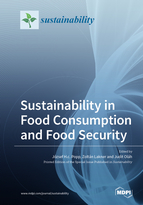Sustainability in Food Consumption and Food Security
A special issue of Sustainability (ISSN 2071-1050).
Deadline for manuscript submissions: closed (29 February 2020) | Viewed by 85479
Special Issue Editors
Interests: agricultural economics; bioenergy; climate change; food security; circular economy
Special Issues, Collections and Topics in MDPI journals
Interests: food system analysis; econometrics and mathematical modeling in food chain; food chain
Interests: logistics management; food; bioenergy; food chain; Industrie 4.0
Special Issues, Collections and Topics in MDPI journals
Special Issue Information
Dear Colleagues,
The transformation of food chains towards sustainability in food consumption and food security is a global issue, connected with the global challenges of poverty reduction, employment and urbanization. Combating malnutrition—undernutrition and micronutrient deficiencies—as well as overweight and obesity is an increasing problem. Research can find sustainable solutions to challenges facing the global and national food systems relating to sustainable food consumption and food security. The integrative food systems approach encompasses all of the steps involved, from growing through to processing, transporting, trading, purchasing, consuming food, and disposing of or recycling food waste. The main topics to be examined are the following: Ensuring sustainable food production (land and sea), sustainable diets and sustainable communities, including issues for agricultural transformation in face of increasing competition for land use; promoting healthy food systems and increasing the focus on nutrition, with multiple implications for diet quality, vulnerable groups, and informed choice; biotechnology could play an important role in climate change mitigation (e.g., nutrient-efficient plants) and adaptation (e.g., drought-tolerant plants), renewable energies, biodegradable products, rural development, and global food security; identifying the means to promote resilience, including resilience in ecosystems and in international markets; responding to climate change and other environmental and social change. The focus should also cover issues for vulnerable groups such as mothers and children, the elderly, patients, and migrants to understand the general aspects of consumer behavior. Sustainability related to product standards and reactions of consumers to these standards are also of great importance.
Prof. Popp József
Prof. Zoltán Lakner
Dr. Judit Oláh
Guest Editors
Manuscript Submission Information
Manuscripts should be submitted online at www.mdpi.com by registering and logging in to this website. Once you are registered, click here to go to the submission form. Manuscripts can be submitted until the deadline. All submissions that pass pre-check are peer-reviewed. Accepted papers will be published continuously in the journal (as soon as accepted) and will be listed together on the special issue website. Research articles, review articles as well as short communications are invited. For planned papers, a title and short abstract (about 100 words) can be sent to the Editorial Office for announcement on this website.
Submitted manuscripts should not have been published previously, nor be under consideration for publication elsewhere (except conference proceedings papers). All manuscripts are thoroughly refereed through a single-blind peer-review process. A guide for authors and other relevant information for submission of manuscripts is available on the Instructions for Authors page. Sustainability is an international peer-reviewed open access semimonthly journal published by MDPI.
Please visit the Instructions for Authors page before submitting a manuscript. The Article Processing Charge (APC) for publication in this open access journal is 2400 CHF (Swiss Francs). Submitted papers should be well formatted and use good English. Authors may use MDPI's English editing service prior to publication or during author revisions.
Keywords
- Food from land and sea
- Food and nutrition security
- Reducing waste in the food chain
- Food science and technology
- Sustainable agri-food value chain and labels
- Digitalisation in the food chains
- Obesity
- Innovative, sustainable diets
- Global markets, fair trade
- Sustainable transportation
- Local food shopping habits and attitudes
- Ethical consumption
- Behavior change
- Sustainable crop protection
- Genetic engineering, biotechnology








